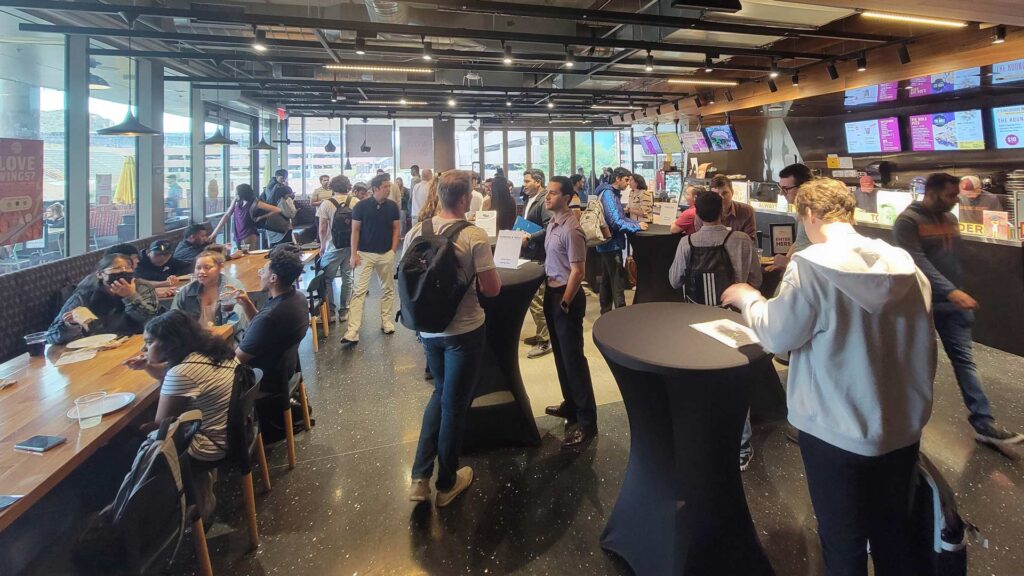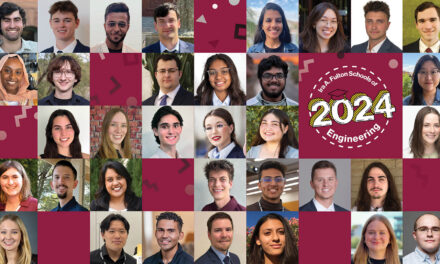
Enhancing education through built environment and construction artistry
College Avenue Commons provides students in one of ASU’s engineering schools not simply a home but a community

“Whatever good things we build end up building us.”
— Jim Rohn, American entrepreneur, author and motivational speaker
As with the world’s natural environments, built environments range from the lackluster to the inspiring, from all but useless to nothing short of essential.
Those in the building professions extol the best examples of skillfully integrating construction and design as those that create an inviting ambiance in a space through an artistic interplay of form and function.
They speak of the synergy that exists between architecture and productive interactions that the best of buildings can motivate in the people who inhabit and work in them.
From that viewpoint, Professor Ram Pendyala sees the College Avenue Commons, or CAVC, building as a testament to the commitment of the school he directs to practice what it preaches.
As headquarters for the School of Sustainable Engineering and the Built Environment, part of the Ira A. Fulton Schools of Engineering at Arizona State University, Pendyala says the modernistic five-story, 137,000-square-foot, nearly block-long CAVC building on ASU’s Tempe campus reflects the school’s hands-on, learning-by-doing approach to educating students that produces not only experts but innovators.
The school offers bachelor’s, master’s and doctoral degree programs spanning a variety of civil engineering, construction engineering, construction management and technology, environmental engineering and sustainable engineering fields.

Students can meet in casual indoor settings at the College Avenue Commons Building for social mixers with industry representatives. Photographer: Kamil Kaloush/ASU
Aiding community building endeavors
Pendyala and other faculty members say CAVC offers an aesthetic array of architectural and design elements that serve as exhibits of expertise in those fields, as well as demonstrating how a creatively designed and constructed environment can help foster a sense of community.
The building’s architecture and design features also pointedly encourage camaraderie and collaboration among students, says Professor Matthew Eicher, the school’s assistant director for industry outreach.
“The spaces are purposely fashioned to be open and communal. They naturally draw students to hang out before and after classes, and that can just naturally lead to cooperative actions that evolve into connectedness and teamwork that are very valuable to their education,” Eicher says.
“Our mission from the start was to build classroom facilities to encourage group learning,” says Professor Samuel Ariaratnam, Sunstate Chair of Construction Management and Engineering programs in the Del E. Webb School of Construction, part of the School of Sustainable Engineering and the Built Environment.
“We specifically wanted cluster-style classrooms, which I like to teach in. I think they facilitate better learning scenarios,” Ariaratnam says. “They give students experience in the group communication and collaboration that they will need to engage in during their careers.”
He notes that many former students from the days before CAVC was built a decade ago have toured the building.
“Every one of them loves CAVC. They say, ‘Why couldn’t we have been in this building?’” he says.
Inventiveness in high tech-oriented architecture
Ariaratnam and some of his faculty and administrative colleagues note specifically how CAVC has had many positive impacts. They say the building has given the school a more distinctive, attractive, professionally stylized and productive site for student internship and job recruitment interview sessions, career fair events, research conferences and engineering and construction business gatherings.
Especially meaningful, school leaders say, is how the building showcases the kinds of appealing and inventive visual, architectural, photogenic and educational features that epitomize the best of today’s high tech-oriented building and construction practices — both aesthetically and structurally.
“The only acceptable goal for the Del E. Webb School of Construction is to be the best construction program on the planet, and to do that it needs to have some of the best degree programs both on campus and online and a home base that exhibits a high caliber of excellence,” says Professor Timothy Becker, eminent scholar and programs chair for the construction school within the School of Sustainable Engineering and the Built Environment.
CAVC aids in striving to fulfill that aspiration “by being a physical representation of the legacy and the quality of the Del E. Webb School of Construction that is visible through the quality of the building’s construction and design,” he says.
“Everybody here talks about the perfect 90-degree angles of the electrical conduit that is part of the building and of the pride in the quality that’s exhibited by the building overall, which is a good physical representation of the Del E. Webb legacy,” Becker says.
“From a perspective of recruiting the best students and the best faculty, it does make a difference where the learning happens and where the work happens,” he says. “The opportunity to work in an outstanding building is really an attraction for students and their parents and for faculty and staff.”

Attendees at a Forum for the Advancement of Women in Construction event gathered in a large outdoor patio space at the College Avenue Commons building. Students and faculty members say having such gathering spaces gives students opportunities to develop relationship-building skills that can be important to advancing their professional careers. Photographer: Timothy Becker/ASU
Spaces foster productive working relationships
Keith Hjelmstad, an ASU President’s Professor of Civil, Environmental and Sustainable Engineering, recalls creating The Mechanics Project more than a decade ago to improve teaching and learning in challenging sophomore-level mechanics courses in statics, dynamics, and deformable solids. The project was launched a short time before CAVC opened.
One of the main features of the Mechanics Project was the implementation of flipped classrooms, in which students worked in groups during class time while instructors and teaching assistants circulated among the groups to help students solve the lesson’s problem of the day.
“The classrooms in CAVC were designed with group work in mind,” Hjelmstad says. “We had first tried to do the flipped classroom in more traditional classrooms before CAVC opened. The difference in the learning environment in CAVC was like night and day.”
The open spaces throughout the building also set the stage for students to easily congregate to work between classes.
“It provides a quasi-social environment for them but allows them to be productive between classes. Every day I see students hanging out there and often working together on assignments,” Hjelmstad says.
“Our students have great camaraderie and part of that comes from providing spaces where working relationships can develop, he says. “As a faculty member, I can stop for a casual conversation with students as I pass through the area on the way to my office. It is also fortuitous that one of these open spaces is next to our advising office.”

Video and audio capabilities in the College Avenue Commons building provide students valuable and convenient opportunities to gather to view educational presentations at events such as graduate student career nights. Photographer: Jagadeesh Chandra Kokkirala/ASU
CAVC features cultivate learning experiences
When speaking about CAVC, Hjelmstad notes the well-known statement by the late renowned prime minister of the United Kingdom, Winston Churchill: “We shape our buildings; thereafter, they shape us.”
The gist of the statement “goes double for education,” he notes.
“Having classrooms specifically shaped for interactive group learning, as they are in CAVC, has fostered learning in ways that even surprise me sometimes,” Hjelmstad says.
“There really is intrinsic value to the person-to-person approach to learning, and our efforts in The Mechanics Project have proven that over and over again,” he says. “The environment in CAVC allows us to add value that is not possible to achieve in other educational settings.”
Kamil Kaloush, the undergraduate program chair for civil engineering and FORTA Professor of pavement engineering, also emphasizes how the building encourages “a sense of unity” among the school’s students, faculty and staff.
“It has many sustainable design features such as good natural lighting and energy-efficient systems to create a conducive learning atmosphere,” Kaloush says. “The facilities are frequently used by industry partners and supporters of our programs to hold career fair events and social mixers with students.”
More than that, he adds “CAVC is an excellent hub for innovation, learning and collaboration between students, faculty and industry partners. There is no doubt about its importance to both the current and evolving needs of the school.”
Beacon of engineering’s meaningful impact
CAVC is also a touchstone of communal spirit for students in the School of Sustainable Engineering and the Built Environment degree programs, says Professor Treavor Boyer, chair of the school’s undergraduate and graduate environmental engineering program
“Most of our students will start and end their college experience there. Even if their degree programs aren’t based at CAVC,” Boyer says. “Most of them will take the ASU 101 course in the building, and many will attend professional development and networking events, award ceremonies and graduation-related gatherings in CAVC.”
Especially meaningful for the environmental engineering students and faculty, CAVC has earned the U.S. Green Building Council’s Gold Leadership in Energy & Environmental Design certification, one of the leading honors for achievement in “green building” and sustainable construction.
School director Pendyala sees the building as playing a vital role in making the school more than a beacon of hope for higher education in some of today’s most vibrant fields of engineering. He views CAVC as a major catalyst “for making a home and building a community” for students, educators, professionals and researchers dedicated to providing the rest of the world with equally enriching built environments.
This article is the second of a series focusing on the role of the College Avenue Commons building in contributing to the evolution of the School of Sustainable Engineering and the Built Environment. Read the first article here.


































